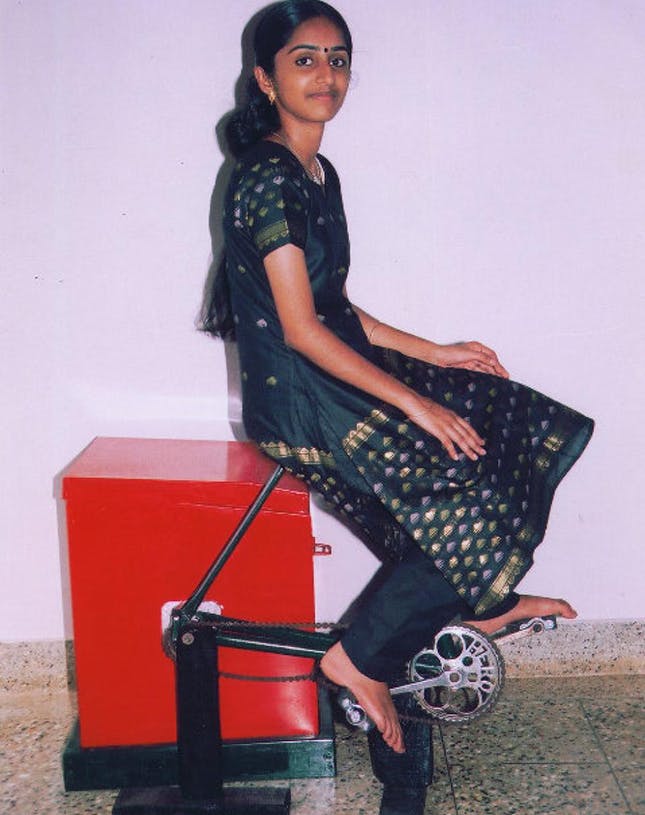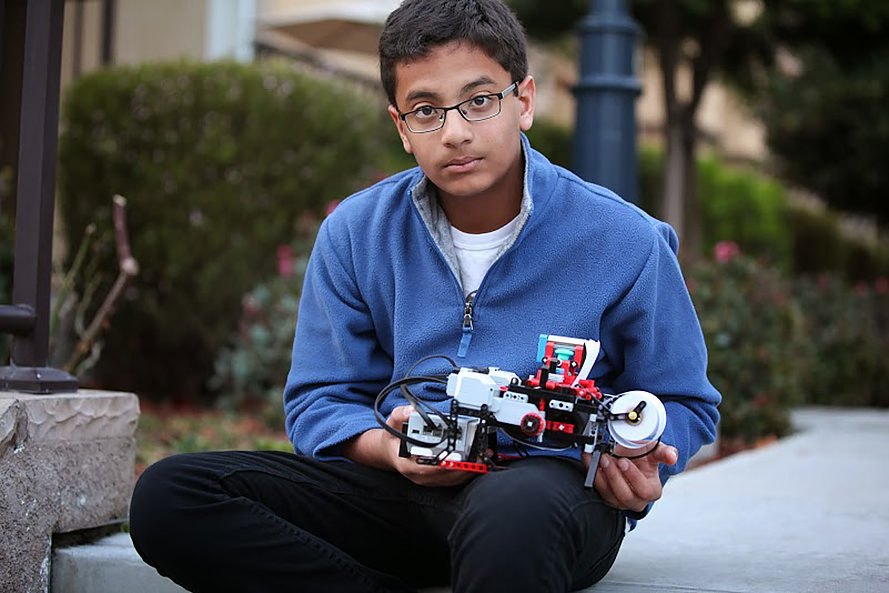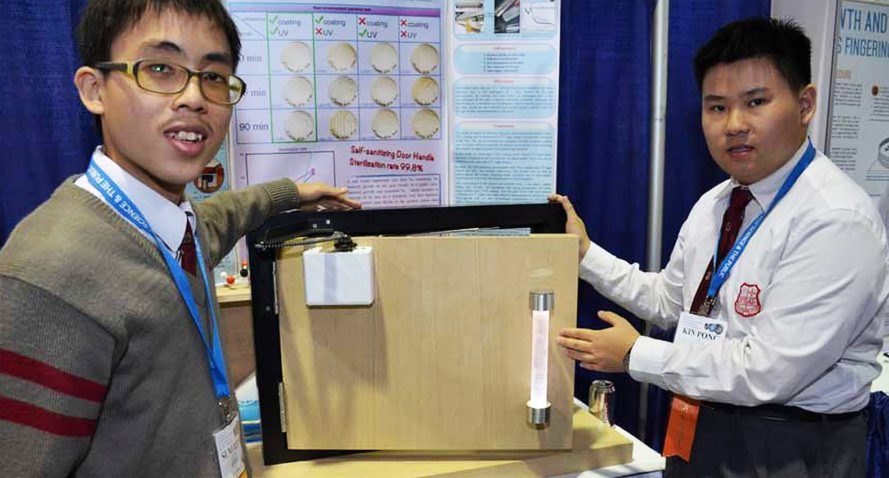- Good Stuff -
- 6mins -
- 3,445 views
14-year-old Indian schoolgirl invents a pedal-powered washing machine for those with no electricity
The inventor of the off-grid washing machine-cum-exercise-bike made from recycled cycle parts even won a National Award for her design.
Off-grid washing machine offers hope to so many without access to electricity
Meet Remya Jose, from Kerala, India. Now 23 years old, Remya is a gifted innovator with a number of ingenious inventions to her credit. The washing-cum-exercise bike that she developed when she was just 14 years old received a National Innovation Award from former Indian President Abdul Kalam.
Amazing off-grid appliance invented by schoolgirl is made from bits of old bike
Not many of us in the West can imagine what it is like to do laundry for an entire family, by hand, every single day. Fourteen-year-old Remya Jose had no choice. Despite a total of four hours daily travel to get to and from school, she and her twin sister were responsible for the task from the moment their mother fell ill, while their father was already undergoing treatment to battle cancer.
The task isn’t easy, particularly if you are using cold river water, and this was when Remya decided to come up with an alternative solution. After studying what an electric washing machine could do, she was able to design a mechanical one which uses a pedal system connected to an aluminium drum by a standard bike chain.
The design was then constructed by a local auto-repair shop from old bicycle components. The washing machine can handle a load of laundry in around 30 minutes, of which only 4-5 mins are required for actual pedalling at the beginning, and a further 4-5 minutes at the end of the cycle to rinse. The rest of the time goes to soaking the clothes in soapy water. The dirty water is drained out through a faucet, leaving space for new, clean water to go in before the last spin.

The Serial Innovator now works for the National Foundation in India
Remya Jose hails from the Kizhattoor Panchayat in the Malappuram district of Kerala, southern India. Her father is a high school teacher and her mother is the headmistress of an Upper primary school. A model student throughout her school years, Remya scored above 90% in her board exams (all this in spite of having to do the laundry!).
She represented her school at various science fairs and won prizes for making a still model of a transmission tower for mobile phones, and for a working model of an indigenous casserole which conserves heat, thus also functioning as a thermal cooker.
For her 12th standard practical examinations, she made a model of a refrigerator in which fruit and vegetables, etc. would remain fresh up to a week.
Jose made this washing machine after her board exams, when she was just 14 years old. She still holds the patent on her washing machine. Now in her mid-20s, she works as a Serial Innovator at the National Innovation Foundation in India (the same foundation that awarded her a prize as a schoolgirl), creating new inventions to help rural communities in her home country.
Below: more teen inventors whose innovations have the potential to change the world.

More teens whose inventions could help improve lives
1. 16-year-olds discover way to increase crop yields for Combating the Global Food Crisis Project
Garden-loving Irish teenagers Ciara Judge, Émer Hickey, and Sophie Healy-Thow, won the Google Science Fair 2014 with their Combating the Global Food Crisis project. The 16-year-olds paired a bacteria often found in symbiotic relationships with legumes with crops it doesn’t typically associate with, namely oats and barley. Crops that tested their unique pairing were wildly successful, germinating in about half the time and producing a 74 percent greater dry-mass yield. Increasing crop yields is vital as the global population grows, and discoveries like this one could greatly impact the way we combat food poverty.
2. 19-year-old invents Ocean Cleanup Array
For several years now, we have been closely following the efforts of The Ocean Cleanup CEO Boyan Slat of the Netherlands, who at 19 years old invented an Ocean Cleanup Array, and we’re continually impressed by his persistence. The Ocean Cleanup recently completed their first aerial reconnaissance mission of the Great Pacific Garbage Patch. The results weren’t pretty – 1,000 large plastic pieces spotted in two hours – but there’s still hope to clean up the mess we’ve made. The Ocean Cleanup won the Katerva Award in 2016, and feasibility studies indicate one 63-mile array could “remove 42 percent of the Great Pacific garbage patch in only 10 years.”
3. 12-year-old builds inexpensive, working Braille printer
12-year-old Shubham Banerjee of California utilised a Lego Mindstorms EV3 kit and about $5 of hardware from Home Depot store to design an innovative Braille printer, the Braigo v1.0, that cost way less than similar devices. Around 285 million people are visually impaired worldwide, according to World Health Organisation data, but as Braille printers cost over $2,000 when Banerjee invented his device, his disruptive technology held the potential to change how the blind communicate. He went on to start a company, Braigo Labs, and about three years later, has released an app and web platform and continues to develop his groundbreaking printer (and he’s still in high school!)
Source: Inhabitat

Another 4 teens whose inventions could change the world for the better
4. 17-year-old creates a device that can purify water and produce clean energy simultaneously
Millions of people around the world live without electricity or clean water, and 17-year-old Cynthia Sin Nga Lam of Australia decided to tackle both issues at once with her portable H2Pro device. The H2Pro unit harnesses photocatalysis, or using light to speed up a chemical reaction, to sterilize water. As a side bonus, the process also yields hydrogen, which Lam said could be used to produce electricity.
5. 17-year-old designs human waste bioreactor to turn human poo into clean energy
When Kenya‘s Maseno School opened up new dormitories for over 700 students in 2013, the area around the students’ home often smelled because of pit latrines and a defective sewage system, which also polluted local freshwater. High schooler Leroy Mwasaru and four friends came up with a solution: a human waste bioreactor that could transform waste into a clean cooking fuel for the kitchen, which had been using firewood. Today, Mwasaru is the founder of Greenpact, a group aiming to provide biogas solutions to over six million Kenyans who lack access to adequate sanitation and renewable energy.
6. 17-year-old and 18-year-old design $13 germ-killing door handle
17-year-old Sun Ming (Simon) Wong and 18-year-old King Pong (Michael) Li of Hong Kong knew bacteria spreads via handles on doors or shopping carts touched by hundreds of people daily. So they hunted for a material that could kill that bacteria and found an answer in titanium oxide. Instead of simply coating a handle in titanium oxide, though, they added an LED light into a bracket holding the handle to truly activate the compound, which can then annihilate 99.8 percent of germs. Even better, the device only costs around $13, meaning it could be accessible for more people worldwide.
7. 16-year-old utilises ingredients found in pencils and sunscreen to create pollution-cleansing coating
Sunscreen and pencils might not be the first two items you’d go to for answers to clean up pollution, but 16-year-old Samuel Burrow of England utilised two ingredients found in those common items to create a “paint-like coating” that has the power to break down pollutants with the help of light. He mixed titanium dioxide with graphene oxide for a concoction with not one, but several applications, in addition to a surface paint. As a sponge, Burrow’s mixture can purify water, and when combined with sand, it has the potential to filter heavy metals out of water — Just imagine how clean the world could be if all buildings were painted with Burrow’s marvelous mix.
Source: Inhabitat


